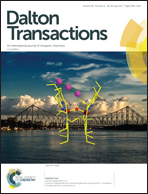Different conjugated system Zn(ii) Schiff base complexes: supramolecular structure, luminescent properties, and applications in the PMMA-doped hybrid materials†
Abstract
A series of Zn(II) complexes with different conjugated systems, [ZnL1Cl2]2 (Zn1), [ZnL2Cl2] (Zn2), [Zn(L3)2]·(ClO4)2 (Zn3), [Zn2L4Cl4] (Zn4), and [ZnL5Cl2] (Zn5), were synthesized and subsequently characterized via single crystal X-ray diffraction, 1H and 13C NMR, FT-IR, elemental analyses, melting point, and PXRD. The X-ray diffraction analyses revealed that the supramolecular frameworks of complexes Zn1–Zn5 are constructed by C–H⋯O/Cl hydrogen bonds and π⋯π interactions. Complexes Zn1–Zn3 feature 3D 6-connected {412·63} topological structures, whereas complex Zn4 exhibits a 3D 7-connected supramolecular framework with a {417·64} topological structure. However, complex Zn5 shows one-dimensional “wave-like” chains. Based on these varied structures, the emission maximum wavelengths of complexes Zn1–Zn5 can be tuned in a wide range of 461–592 nm due to the red shift direction of λem caused by different conjugated systems and their electron donating abilities. Complex Zn3 shows a strong luminescence in the solid state and in the acetonitrile solution. Therefore, a series of Zn3-poly(methylmethacrylate) (Zn3-PMMA) hybrid materials were obtained by controlling the concentration of complex Zn3 in poly(methylmethacrylate) (PMMA). At an optimal concentration of 4%, the doped polymer film of Zn3-PMMA displays strong green luminescence emissions that are 19-fold in the luminescence intensities and 98 °C higher in the thermal stability temperature compared to the Zn3 film.



 Please wait while we load your content...
Please wait while we load your content...